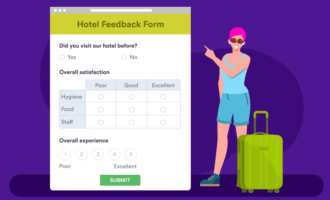Whether it’s a mega-corporation like Walmart or a government department like Health and Human Services, most organizations use surveys to gather feedback from customers and employees or to conduct market research. However, the effectiveness of these surveys is as varied as the organizations they come from.
Surveys are created to gather essential data for organizations. Unfortunately, poorly worded survey questions can skew your results, leading to issues like response bias, which is the tendency of respondents to answer questions falsely for any number of reasons, such as to provide more socially acceptable answers to controversial questions. By carefully wording your questions, you can avoid response bias and make your surveys more effective.
How can you ensure your surveys help you collect user information effectively? To help you create surveys that lead to informed business decisions, we’ll examine 80 survey questions, how they work, and when to use each.
Market research
Market research is typically aimed at your business’s target audience. This type of research allows businesses to tailor their marketing and products to those who are already customers or are likely to become customers.
For example, while huge brands like Starbucks and McDonald’s both specialize in food service, their products and advertising are completely different. This is because of the insights they gain from market research. The following market research questions provide a great starting point for conducting your research.
- Why did you decide to use our company?
When should you ask this? Ideal for first-time customers or individuals committed to a long-term contract, this question can be used after gathering basic demographic information.
What can it do for you? While there may be many benefits to choosing your particular product/service, this question reveals what the deciding factor was for your customers. You can use this data to guide future marketing decisions or sales pitches.
- Where do you usually purchase this type of product or service?
When should you ask this? Try this line of questioning if you’re trying to learn more about the purchasing habits of new clients or scope out your biggest competition.
What can it do for you? When used on a large enough sample size, you’ll be able to get a list of your main competitors and gauge their popularity with your audience.
- How often do you use our product or service?
When should you ask this? This subject is great for businesses that offer a subscription-based service or product. And it can help to determine how long your subscriptions should last.
What can it do for you? The amount of use people get out of your product/service can dictate your pricing and subscription model.
- What problems does the product or service solve for you?
When should you ask this? You may feel that you understand all of your customers’ pain points, but sometimes a product or service can be used in unexpected ways.
What can it do for you? These answers can uncover new uses for your product/service that you can capitalize on.
- What characteristics do you look for in this product or service?
When should you ask this? If you’re considering revising your offerings or adding some upgrades, use this question in your survey.
What can it do for you? By asking this question, you can gather a list of new features that your customers care about.
- What problems do you often encounter with this type of product or service?
When should you ask this? This can be a follow-up to the previous question. While many customers may not know what they want in a product, experienced consumers will be able to say exactly what they don’t want.
What can it do for you? The issues that this question reveals can be used to improve your products and services. If your new products don’t have the typical problems your competitors’ products do, you can incorporate that in your marketing.
- How did you hear about our company?
When should you ask this? If you’ve invested a lot in different marketing platforms, this question can narrow down which ones have reached your audience.
What can it do for you? This data enables you to streamline your marketing to websites and other channels that your target audience interacts with regularly.
- What can we do to improve your future experiences with our company?
When should you ask this? If you’re trying to make your surveys shorter, this question can expose areas for improvement across your company. The broad wording of this query covers your entire business, from customer support to website design to the ordering process.
What can it do for you? These responses can help detect problems in your company that you may not even realize impact your customers.
Customer experience
Customer experience surveys help you see your business through the eyes of clients. These survey forms can be customized based on the part of your business you want to evaluate. For this reason, you may want to make several types of customer experience surveys so you can zero in on specific issues.
When should you ask this? This question can be sent out shortly after the client receives the product. Following up with the customer after the initial excitement of purchasing the item has passed gives you a clearer idea of how customers feel about the product.
What can it do for you? These responses reveal if your products/services live up to customers’ expectations or if you need to enhance your offering.
- Did this product or service help you accomplish your goal?
When should you ask this? This question is perfect for new products/services that haven’t been field-tested yet. It can show whether your idea works in the real world.
What can it do for you? Depending on the answer, you may find that you need to pivot and revise your product/service to work as intended.
- How would you improve the product or service?
When should you ask this? Use this question if you want customer input on how to upgrade your product/service.
What can it do for you? As stated above, client feedback is an invaluable resource for keeping your business fresh and up to date. If you’re getting a variety of answers, it may be a sign that you need to create a line of products that are customized to various customer needs.
- What is the most useful feature of this product or service?
When should you ask this? When determining what to emphasize in your marketing or which elements to keep during a redesign, this inquiry helps you narrow down which product features your customers find the most useful.
What can it do for you? The data gathered from this question allows you to make better marketing and design decisions. You could also use this information to write sales pitches for the item.
- Was our website easy to navigate?
When should you ask this? Include this question anytime you’re interacting with a new customer or going through a major website change.
What can it do for you? Negative responses could indicate that you have serious website issues. If current customers think your website is difficult to navigate, you’re likely losing potential customers.
- How could we improve our customer service?
When should you ask this? If you use yes-or-no questions like, “Did your problem get resolved?” you might miss concerns like long wait times or insufficiently trained staff. Use this open-ended question if you’re trying to track how well your customer service is operating or if any recent changes you’ve made are working in your favor.
What can it do for you? Responses to this question provide a list of issues you can use to refine your company’s customer service. Responses can also show how well any recent customer service changes are being received.
- Will you use our company again in the future?
When should you ask this? One of the biggest concerns for organizations is whether new customers will become returning customers. Use this question if you have concerns about client retention.
What can it do for you? This data tallies how many customers are happy enough with your company to come back. If a significant number of clients will not continue using your business, it’s clear you need to make some changes.
- How likely are you to recommend us to a friend?
When should you ask this? This question is important for tracking how much people enjoy your product/service and if that translates to word-of-mouth marketing for your brand.
What can it do for you? Having a high recommendation rate is a great indicator that clients like your product/service. If surveys show a lot of positive feedback for your business but a low referral rate, that could mean you need to run some promotions to push customers to recommend your offerings.
Product development
Nobody wants to spend all their resources creating a product that customers don’t like or need. Thankfully, you don’t have to. Product development surveys enable you to test ideas before you invest too much in them.
- What is your first thought about this product?
When should you ask this? This question is ideal for both the initial product idea and prototypes, since responses reveal how appropriate the product is for your audience.
What can it do for you? Not only can you learn how your audience feels about a product, but you’ll also be able to gather valuable information for later on in the development process. For example, negative impressions could show potential marketing challenges that you can account for when creating your marketing material.
- How interested are you in purchasing this product?
When should you ask this? Asking this in the beginning stages of product development shows whether the idea is viable and to what extent people like the idea of the product.
What can it do for you? What you learn can save you from wasting resources developing a bad product or give you evidence that there’s actual interest in buying the product.
- Are you satisfied with the product’s performance?
When should you ask this? After you reach the prototype stage, you may use this question to measure how well the finished product lives up to your original idea for it.
What can it do for you? The information you get can help you see which design features still need improvement and what’s working well for your audience.
- How would you rate the quality of this product?
When should you ask this? If your brand specializes in more expensive products, your customers will expect a certain level of quality. Include this question if you know consumers want a high-quality product.
- What changes would you like to see made to our product?
When should you ask this? While you can ask this question in the prototype stage, it’s most useful while you’re still determining what the final product will be and how it will work.
What can it do for you? Answers to this question can identify any needed changes and help you fine-tune the product before mass-producing it. Taking care of these issues on the front end will help save time and money.
- Is this product something you need or something you want?
When should you ask this? Many consumers have reduced their spending, buying only what they need. So determining whether your product is a necessity or a luxury will reveal how big your consumer base will be.
What can it do for you? Understanding the demand for your product will help you design marketing materials. Plus, you’ll be able to identify your target market.
- How does this product compare to similar products in the industry?
When should you ask this? While there may be products similar to yours on the market, you’ve likely created a product with certain features that set it apart from the competition. This question can show if customers think that your improved version is better or worse than what’s available.
What can it do for you? Responses to this question indicate what stands out to customers about your offerings and which parts of your product or service underperform when compared to your competitors.
- What price range do you think this product would sell for?
When should you ask this? Once you’ve ironed out the product’s end design and features, try including this question if it’s unclear whether you’ll make a profit once you factor in all the production costs.
What can it do for you? Price ranges allow you to figure out what your profit margins are likely to be, and they can prevent the product from failing due to being overpriced.
Brand recognition
Everyone wants to be recognized for something, but what if your brand is associated with the wrong ideas? Brand recognition surveys help you see if your core values are being communicated correctly to your audience.
A quick tip: These surveys can be used for both returning customers and individuals who have just stumbled onto your website, as each perspective is important for determining brand recognition.
- Where did you first hear about our brand?
When should you ask this? Use this question when you’re reevaluating the effectiveness of your marketing channels or trying to gauge how eye-catching your advertising is to consumers.
What can it do for you? This shows what strategy and channels best reach your audience and make them want to learn more about your brand.
- When you think of our brand, what values do you associate with it?
When should you ask this? If a particular mission or value drives your organization, you can use this question to learn if that value makes your brand stand out.
What can it do for you? Responses can measure how well your values are being communicated to your audience and if you need to do more to raise awareness of them.
- How would you describe our brand?
When should you ask this? Focusing on a more general topic like this is important for any company trying to increase its brand recognition or figure out what its brand is known for.
What can it do for you? This question gives your team insight into your brand’s image so you can either highlight the positive things you’re known for or change your messaging to clear up any misconceptions.
- How often have you used our products and/or services?
When should you ask this? This establishing question can be used to provide context for the responses you get from the next questions in the survey. It can also determine if customers like your offerings in general.
What can it do for you? Knowing how many times customers have used your merchandise can give clues as to how much they like the product/service and how much use they’re getting out of it.
- How have your interactions with our brand impacted your view of the company?
When should you ask this? Many brands encompass a variety of smaller companies, products, or services. Use this question to measure how well your overall branding boosts your company’s image.
What can it do for you? Answers to this question show if you need to pivot your branding or if it’s contributing to a positive view of your company.
- How likely are you to recommend this brand to a friend or coworker?
When should you ask this? As noted above, your overall brand may include multiple products or services. You can use this question to see if your entire brand warrants a recommendation or if customers recommend only a small section of your offerings.
What can it do for you? This question is great for determining whether your branding is good enough to not only entice customers but also encourage them to tell others about it.
- Which brand is the most well-known in this industry?
When should you ask this? In situations where it’s unclear which of your competitors are dominating your industry or field, you can add this question.
What can it do for you? This can show you which brands are making their mark among your audience and, by process of elimination, which ones you don’t need to worry about.
- What aspects of this brand make it well known?
When should you ask this? When used as a follow-up to the previous question, this question can help you figure out why your competitors are doing well in your field.
What can it do for you? Once you know why respondents like your competitors, you’ll either be able to home in on their strengths or diversify your brand and become better at other aspects of the industry.
Employee surveys
As the economy continues to improve, many businesses will need to retain and hire more employees. But demand is starting to outstrip supply. A May 2021 report by the National Federation of Independent Business found that 48 percent of small businesses had unfilled positions.
By using employee satisfaction surveys, you’ll learn how your current employees view their jobs and glean ideas for improvement so you can hire the workers you need. Plus, by administering these surveys to your employees at regular intervals, you can determine if any workplace changes have been beneficial or not.
- How happy are you with your current job?
When should you ask this? As this is a more general question, you can use it for any employee survey to measure employee satisfaction.
What can it do for you? The overall satisfaction of your employees can either be a sign that your working environment is great or that there are serious problems you need to address.
- Do you feel valued at work?
When should you ask this? You should use this when there are concerns about staff members’ relationships with management or fellow employees.
What can it do for you? If the responses are negative, this can indicate unhappy employees. Boost morale and employee retention by encouraging leadership to commend their employees more and provide special perks.
- Is your average workload manageable?
When should you ask this? If you’re seeing high rates of burnout or an increase in sick leave, this question can reveal if you’re overworking staff members.
What can it do for you? These responses allow you to redistribute your team’s workload more fairly and provide help to employees during busy times.
- How would you rate your immediate manager’s leadership style?
When should you ask this? If specific departments are having high turnover or you’re receiving a lot of HR complaints about management, you’ll want to include this question.
What can it do for you? By seeing how well your managers’ styles mesh with your employees’ styles, you’ll be able to see if there’s a disconnect between them that you need to bridge.
- Do you have the resources and support you need to accomplish your job?
When should you ask this? Add this question when you’re trying to revamp training materials and other employee resources.
What can it do for you? Answers to this question can indicate that you need to invest more in resources for employees and provide them with more workplace support.
- Do you have sufficient opportunities to advance your career?
When should you ask this? High performers who get stuck without any hope of advancement are likely to seek a new job, which means you need to ask this question routinely to prevent great employees from leaving.
What can it do for you? You may learn that you need to invest in more training programs or reevaluate your promotion policies.
- Does the company’s culture contribute to a positive working experience?
When should you ask this? Company culture is a huge factor in whether someone stays at or leaves their job, but it’s difficult to know if your culture is beneficial or toxic. So try using this question if you see a rise in HR complaints.
What can it do for you? By learning what type of culture your company is breeding, you’ll be in a better position to address problematic behaviors or ideas before you lose valuable employees.
- Are there problems not brought up in this survey that need to be addressed?
When should you ask this? There are many facets to working in any job, and no survey can list every potential problem in a workplace. Using this question can help cover the gaps in your surveys.
What can it do for you? Any issues that you didn’t know about can be brought up and evaluated so you can work toward solving them.
Event surveys
Whether it’s a booth at a trade show or an expo sponsored by your company, events are often used to generate leads and increase your brand recognition. Sending out event surveys after the function can help you make sure that your events are living up to your expectations.
- How did you first hear about this event
When should you ask this? In the first few years that you hold an event, you may try multiple marketing strategies to reach your customers. Asking this question can narrow down which strategies are worthwhile and which ones you should drop.
What can it do for you? The information you gather gives you a starting point for the best places and ways to market your event.
- Why did you attend the event?
When should you ask this? Use this question for newer events or if there’s a charge for attending, as it shows what motivated attendees to go.
What can it do for you? These answers allow you to take note of which event promotions are resonating with prospective clients.
- How did attending this event impact your view of the business?
When should you ask this? When you’re pouring your resources into hosting an event to draw in new customers, you’ll need to make sure that any new faces get a positive impression of your company.
What can it do for you? You can learn how well received your event was and how successful it was at generating leads.
- Do you remember any of the event’s sponsors?
When should you ask this? If you’re relying on sponsorships to get the word out about your business, then you’ll want to know how effective your efforts are at making an impression on your audience.
What can it do for you? Once you know whether people remember your company from the event, you’ll be able to decide if you want to continue using this form of marketing.
- If you were able to demo a product, what was your impression of the product?
When should you ask this? For events that focus on vendors, like trade shows, this question can be used to perform quality control on your vendors and their products or to evaluate how your product was received.
What can it do for you? These answers can help you and your vendors improve the product offerings at your events and follow up with new leads.
- Are there any topics, services, or products that you would enjoy seeing at this event?
When should you ask this? For educational or vendor-based events, you may be missing a new topic of interest or a local speaker your audience wants to see.
What can it do for you? Any feature or topic that your audience recommends can be used as a selling point for attending your next event.
- Did you experience any challenges when registering or trying to attend the event?
When should you ask this? This general question helps identify logistical problems.
What can it do for you? By fixing any issues that your attendees experience, you can increase turnout and the overall satisfaction rate.
- Were you satisfied with the networking opportunities at the event?
When should you ask this? If networking was one of the main attractions of the event, you need to make sure it lived up to participants’ expectations.
What can it do for you? Networking can be tricky, so if you see negative responses to this question, you’ll need to make it easier for people to meet. This may involve inviting more people and setting up sessions where clients can meet vendors and other industry professionals.
Educational institutions
Educational organizations use surveys for much more than the average business. This includes surveys for academic research, student or faculty satisfaction, and ideas on which vendors to use for food service or merchandise.
Best practices for institutions like colleges include providing students with a separate email address for school communications and limiting the number of surveys you send. This will also help ensure that you don’t violate student privacy laws like the Family Educational Rights and Privacy Act (FERPA).
- How would you rate the campus climate in terms of being respectful?
When should you ask this? With many schools trying to stop incidents like sexual harassment and discrimination, this question can be a valuable tool for showing what more you can do.
What can it do for you? Responses to this question can show how respectful your staff and students are to each other. Depending on the answers, you may need to hold training sessions or institute new policies to improve your campus climate.
- How would you rate the knowledge level of the professors?
When should you ask this? Course evaluations often ask this question so you can determine how well your professors are meeting the educational needs of your students.
What can it do for you? This question is great for revealing potential problems that can be corrected through continuing education or by assigning a different professor to a course.
- Was it hard to access resources such as tutoring or other forms of academic assistance?
When should you ask this? You’ll need this question if the average grades of students are dropping or if you’re concerned that you’re not providing enough help to students with learning disabilities.
What can it do for you? Answers tell you which academic resources students are having trouble accessing, so that you can make them more readily available.
- Was the school staff helpful?
When should you ask this? If you’re considering additional changes to your staff training or just evaluating your customer service, add this question.
What can it do for you? Feedback from this question enables you to find ways to improve students’ educational experiences and ensure they have access to any needed resources.
- Are the facilities clean and safe?
When should you ask this? This is important for schools that offer in-person education, especially if the school houses younger children.
What can it do for you? Comments on this question will guide you in keeping your buildings and equipment safe and in good condition.
- Do you feel safe on campus?
When should you ask this? Colleges typically have security and anti-harassment policies. This question reveals how well they’re working.
What can it do for you? It can help you address safety concerns so you can provide a safer environment for students and staff.
- On a scale of 1 to 10, how happy were you with the variety of extracurricular activities?
When should you ask this? Use this rating scale question when considering changes in funding or staff assignments for extracurricular activities.
What can it do for you? Responses allow you to decide whether you need more activities or a wider variety of activities to engage students.
- Was the school accessible?
When should you ask this? Because this subject is important for legal reasons, you should use this question in most educational surveys to determine if there are issues with accessibility for students with disabilities. Make sure to include a follow-up short answer question in case the response is negative.
What can it do for you? This question can help you find new ways to improve accessibility for students and ensure your school complies with accessibility laws.
Nonprofit Organizations

Nonprofits often depend on donations to carry out their missions. By using surveys, these organizations can learn which fundraising methods are successful and what messaging style works for their cause. If your nonprofit’s mission is to improve people’s lives, your organization can also use surveys to determine the needs of the people you are helping.
- How did you first learn about our organization?
When should you ask this? Many nonprofits are trying to raise awareness about a cause and help the individuals impacted by the problem. This question is good for evaluating both your marketing and fundraising campaigns.
What can it do for you? This question helps pinpoint what marketing works and what can be improved.
- Was the donation process easy to complete?
When should you ask this? Use this question if you’ve recently implemented new donation systems or are seeing many people drop out of the donation process partway through.
What can it do for you? This question can help you find and clear up bottlenecks in your process, which increases your overall donations.
- Was it clear how your charitable donation would be used?
When should you ask this? Some donors worry that only a small part of their donation will help others, or they’re unclear about your mission. This question ensures that you’re transparent about how donations are used, which is essential to maintaining good donor relationships.
What can it do for you? Responses will help you measure whether your content about donations is easy to find and understand.
- What motivated you to volunteer at our organization?
When should you ask this? This question can reveal how people discovered your volunteer opportunities. It also shows whether your marketing is compelling for potential volunteers.
What can it do for you? Answers to this question can help you adjust your marketing to attract more volunteers.
- On a scale of 1 to 10, how satisfied are you with your volunteer experience?
When should you ask this? If you’re having trouble retaining volunteers or are receiving complaints, this question will break down how people feel about volunteer work with your organization.
What can it do for you? Through further investigation, you can fix issues and improve volunteers’ satisfaction levels.
- Did you feel that the training you received prepared you for your volunteer work?
When should you ask this? This question is especially important if the volunteer work could be hazardous, such as environmental clean-up efforts or complex tasks.
What can it do for you? It can identify gaps in your training process that you can work to fill. This makes the volunteer service safer and more enjoyable and helps you retain volunteers.
- How easy is it for you to access our services and support?
When should you ask this? Use this question to poll people your organization aims to assist, as there may be unseen barriers preventing people from getting the full benefit of your services.
What can it do for you? Answers to this question can help you improve the ways you offer assistance and perhaps uncover a new way to help people.
- Are there any needs or gaps in services that we could fill?
When should you ask this? Include this question on your organization’s annual surveys because changes in government funding or services may cause people to lose the support or assistance they once had.
What can it do for you? Responses allow you to tailor your assistance to people’s current circumstances and resources so that they don’t lose out on vital support because of a change in government policy.
Healthcare companies
Healthcare organizations are tasked with providing vital medical care while keeping their patients happy. By using patient surveys, medical institutions can track the efficiency of their work and overall patient satisfaction.
Healthcare surveys must be HIPAA-friendly. If you’re collecting demographic information or medical data, this information must be private and secure. To keep patients happy, allow patients to opt into receiving surveys so that they don’t feel pressured to provide personal information for nonmedical purposes.
- Were you able to make an appointment that fits your schedule?
When should you ask this? If you hear complaints about your available booking times, or if patients are missing appointments or are often late, this could be the cause.
What can it do for you? It can help you determine whether certain doctors need to stop taking on new patients or at least pare down their patient schedule.
- Was it easy to navigate the clinic/hospital?
When should you ask this? If your practice is part of a large building complex or you’re concerned about accessibility, include this question.
What can it do for you? Negative responses to this question indicate you need more signs posted, a greeter at the door, or better accessibility in the building itself.
- How satisfied were you with the appointment check-in process?
When should you ask this? The check-in process can be lengthy, especially for new patients. Try this question to see if patients are getting overwhelmed by the process or if the front desk is getting bogged down by paperwork bottlenecks.
What can it do for you? It can help you identify issues with your process so you can correct or streamline them, or better communicate with clients.
- Did you need to wait past your appointment time to receive care?
When should you ask this? Use this question if you have complaints about wait times.
What can it do for you? This question can reveal which providers are struggling with their workload or if there are scheduling problems.
- How long past the appointment time did you wait?
When should you ask this? Use this as a follow-up question if the person taking the survey answered yes to the previous question.
What can it do for you? Feedback from this question can determine how far behind your practice typically is so you can adjust scheduling accordingly.
- Were staff members kind and courteous?
When should you ask this? All patient surveys need this question, as it evaluates the entire team instead of just the doctor.
What can it do for you? It can uncover customer service problems that may require more training to correct.
- Were your medical questions answered?
When should you ask this? Patients often make appointments because they have a specific concern, so this question can be used for most medical visits.
What can it do for you? This question shows whether the provider was able to address all the patient’s concerns and if they were able to communicate well with the patient. Negative responses may reveal a need for longer appointments or training on communication for providers.
- How satisfied are you with your doctor?
When should you ask this? Use this question when surveying a new patient or a patient who recently had to switch providers.
What can it do for you? A good doctor-patient relationship is one of the main reasons patients stay with a healthcare organization. This question determines if the patient feels comfortable with the new doctor or if they need a different one.
Membership organizations
Establishments like lodges, country clubs, and honor societies focus on providing services for their members. Surveys help improve members’ benefits and reveal ways to increase member acquisition and reduce attrition.
- How long have you been a member of this organization?
When should you ask this? This is a standard question used to establish how long someone has been involved with your organization and is typically used to provide context for subsequent questions.
What can it do for you? This question helps determine which events members could have attended during their membership period, whether they have previously renewed their membership, and what changes have occurred while they have been members.
- What membership advantages do you enjoy having?
When should you ask this? If you’re determining which benefits to keep and which to cut, you must find out what your members get out of their membership.
What can it do for you? This question helps weed out the unnecessary benefits from the ones that members stick around for.
- Is the price of your membership worth the benefits it provides?
When should you ask this? This question is key if you have a high initial joining cost or require members to renew regularly.
What can it do for you? If the cost is considered too high compared to the rewards, you need to evaluate whether you need to change your prices or add benefits.
When should you ask this? Use this question if you host many events, have low attendance for events, or are measuring how engaged members are with events.
What can it do for you? Responses show how popular your events are with your members.
- Which of our events/activities/meetings do you like the most?
When should you ask this? Use this question if you have a variety of events and are trying to prioritize the best ones.
What can it do for you? It can help you pinpoint which events are popular and which can be cut or improved.
- Which of the events/activities/meetings do you like the least?
When should you ask this? Again, this is important if you have a variety of events and are streamlining your offerings.
What can it do for you? Responses identify which activities are deemed boring or unenjoyable by members, allowing you to make changes or stop hosting them.
- What changes do you believe need to be made to the organization?
When should you ask this? Use this survey question if you can’t retain members or have low event attendance or a poor member satisfaction rating.
What can it do for you? Feedback from this question will reveal what members don’t like about your organization so that you can make necessary changes and retain members.
- How likely are you to renew your membership?
When should you ask this? If your organization requires members to pay a renewal fee after a certain amount of time, this question can determine whether you’re likely to retain the members you have.
What can it do for you? If you find that a significant percentage of your membership base will not renew, it’s clear that some changes need to be made. The previous questions listed can provide insight into why this is and what you can do to fix it.
Design a short survey and get the data you need
Every organization can benefit from surveys, but using them correctly is an art. By understanding which questions to use and when to use them, you’ll get real insights to help you make impactful changes in your organization.
At Jotform, we offer the survey-building tools and templates you need to create the perfect survey. Our premade templates offer a starting point for whatever type of survey your organization needs.






































































































Send Comment: